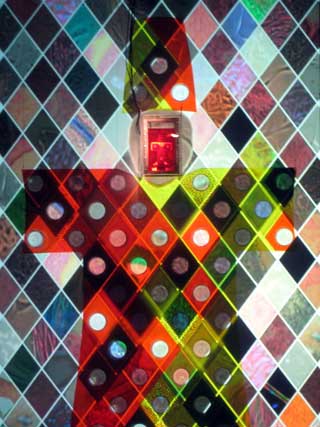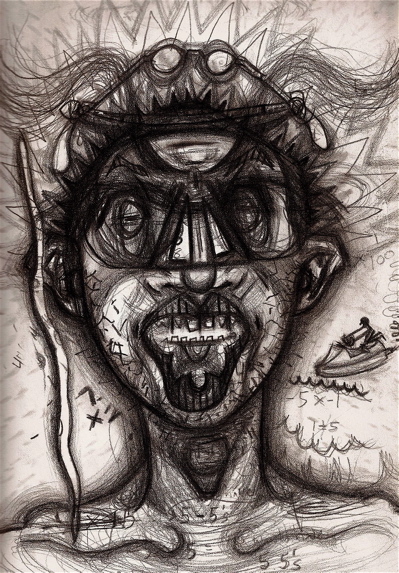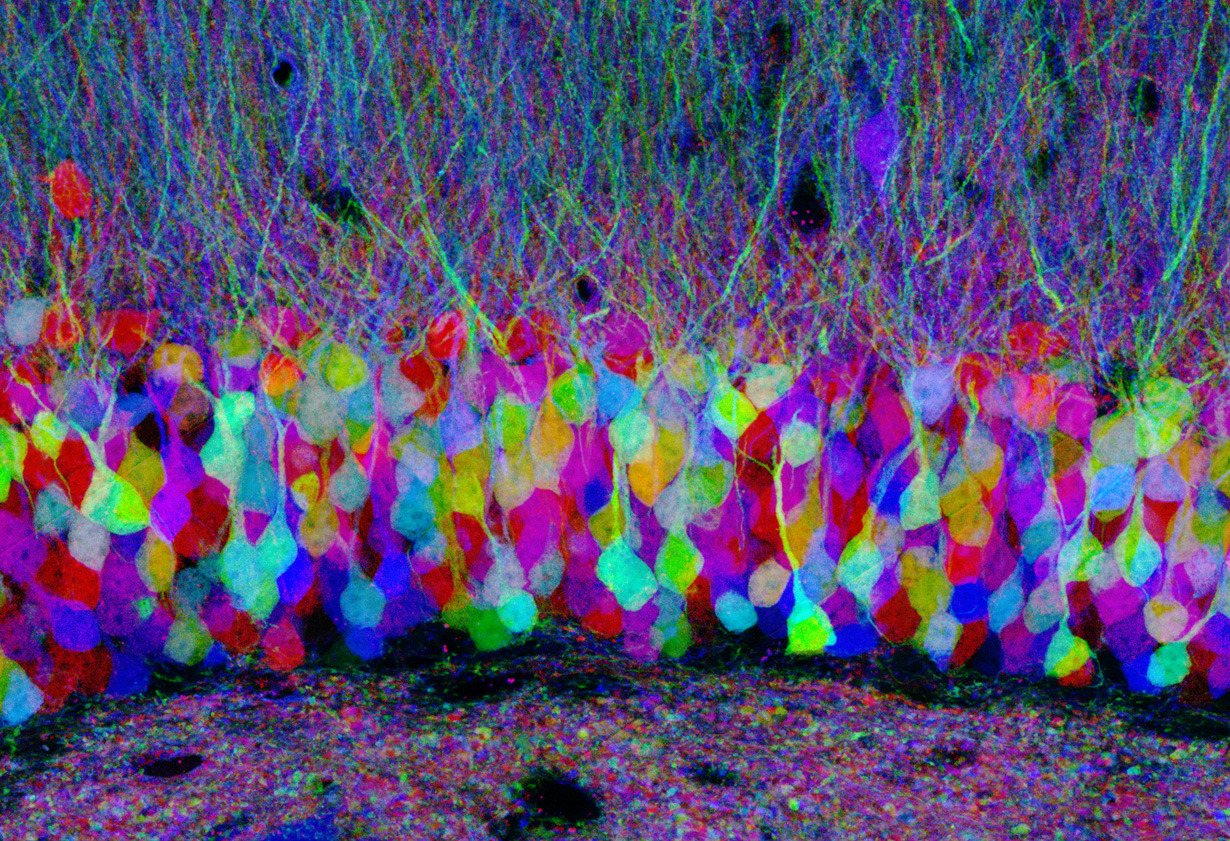In light of the recent advent of biotechonology, it is no surprise that this field can influence current artists and their works, or cause new forms of art to emerge today. An example of a new medium of artistic expression is the "bioart" created by Joe Davis. Davis utilized various biotechnological equipment and bacterial samples to create works of bioart, including audio microscopy (captures light and translates them into acoustic signatures, very reminiscent of Silvia Casnini's essay on MRI acoustic art) and bacterial genomes to encode his artpiece, the "Microvenus".
Davis' "Microvenus"
Speaking of medical technology, it appears that it is inherently similar biotechnology due to the same biological issues they need to address and be employed for. Consequently, we see examples of biotechnology that can be used for medicine like 3D organ and tissue printing. Ordinarily, printers are a technology that we normally use for certain art media such as copies of paintings, photography, printed computer/digital art, and - in the case of 3D printers - sculptures. However, it appears that in the future, we may indeed be able to use artistic instruments like these to create tissues for biotechnological research and to solve many medical problems with extra donor organs.
In his TED Talk, Anthony Atala goes over our current advances in 3D tissue and organ printing.
In the first episode of a three-part Discovery Channel series called 2057, futurist Michio Kaku predicts that we can utilize current 3D printing technology to create organs from scratch for patients in need of new ones.
Orlan, the infamous artist who used medical technology like plastic surgery to create her works of performance art, shows up again in relation to biotechnology for her masterpiece the "Harlequin Coat". Arguably the most influential piece in terms of my understanding of biotechnology and art, Orlan constructs a polychromatic coat of diamond-shaped Petri dishes with samples of skin cells of individuals of different "races". Although the biotechnological aspect of this coat stands out immediately, the questions it raises later - about hybridization of races, tissue ownership, and the perspectives of other cultures on matters like this - make it apparent that it really is a work of art as well, as art is intended to evoke an emotional response or make the audience ask critical questions about their current reality.
Orlan's "Harlequin Coat"
In addition to bringing about emotional responses, a result of cognitive functions, artists have also harbored a great interest in the brain and the conscious and unconscious mind. A pioneer in one field of understanding the brain, phrenology, is Franz Joseph Gall. His work involved categorizing the brain into twentyseven separate organs of cognitive function and measuring different bumps of the brain to ascertain particular behavioral traits of individuals, such as their susceptibility to commit crime (very similar to the erroneous and social-Darwinist field of craniometry, but I suppose there is a reason why phrenology has been deemed a pseudoscience).
The different organs of cognitive functions, as drawn by Gall onto a model skull
Another influential neuroscientist is Santiago Ramon y Cajal, who strived to understand neural connections and comminucation; he looked at the shape of neurons as well as their degeneration and regeneration in relation to neuron theory. Ramon y Cajal states that only artists are attracted to the sciences (he was even an aspiring artist himself prior to going into the scientific profession), which explains his colorful comparison of neurons to "butterflies of the soul."
Ramon y Cajal's claim would also explain the proliferation of art inspired by the growing field of neuroscience, as seen in Suzanne Anker's work on fMRI butterflies. In her pieces, she would post multiple brain scans with identical butterfly patterns superimposed on each scan; however, since each scan is different and has distinguishing Rorschach blots on them, it creates an optical illusion to make it seem like each butterfly is different on each scan. This is not only an example of utilizing common neuroscience techniques like bran scanning, but also raising the questions of what makes our "butterflies of the soul" perceive these works of optical illusions in these ways.
Anker's fMRI butterflies
What I imagine would be one of the most influential neuroscientific factors in creating art is the use of psychedelic drugs. Not only have these drugs influenced the work of many psychologists and scientists such as Sigmund Freud and Timothy Leary in understanding neuroscience, but they have also influenced the work of artists like Vincent Van Gogh and Bryan Saunders. The latter artist intentionally draws a self portrait for each different psychedlic drug to see the effects of them on his cognitives functions and their result in his art.
Saunder's self portrait under the use of cocaine
Even other art pieces inspired by neuroscience look psychedelic as well, as seen in the artworks produced by the Brainbow project and the Human Connectome Project. These projects took aspects of the brain and neural circuitry to create wondrous multi-colored works of art that also function as a scientific finding in further understanding the anatomical components of neuroscience. For the Brainbow pieces, they colored each individual neuron so they can be distinguished from each other; for the Human Connectome Project, pieces showing the colored myelin networks outline the otherwise hidden neural connections of the brain using MRI scans. These I believe are just some of the key examples of art inspired by scientific disciplines like neuroscience and biotechnology to come.
A piece produced by the Brainbow project
Alternative rock band Muse's album cover, an image created by the Human Connectome project
Sources/Links:
1)More on Anthony Atala's TED Talk: http://www.ted.com/talks/anthony_atala_growing_organs_engineering_tissue.html
2)More on Michio Kaku and the "2057" series: http://dsc.discovery.com/tv-shows/curiosity/topics/michio-kaku.htm
3)More on phrenology: http://psychology.about.com/od/historyofpsychology/f/phrenology.htm
4)More on Vincent van Gogh's drug use: http://www.finerminds.com/personal-growth/5-famous-iconic-drug-users-that-inspired-the-world/
5)More of Bryan Saunder's work: http://www.finerminds.com/personal-growth/5-famous-iconic-drug-users-that-inspired-the-world/
6)The Human Connectome Project: http://www.finerminds.com/personal-growth/5-famous-iconic-drug-users-that-inspired-the-world/
Works Cited:
Casini, Silvia. "Magnetic Resonance Imaging (MRI) as Mirror and Portrait: MRI Configurations Between Science and the Arts." https://instructure-uploads.s3.amazonaws.com/account_30000000000529/attachments/1377959/19.1.casini.pdf?AWSAccessKeyId=AKIAJBQ7MOX3B5WFZGBA&Expires=1374353302&Signature=WNo5VPkZNAdayQR518ye56IqXgA%3D&response-content-disposition=attachment%3B%20filename%3D%2219.1.casini.pdf%22%3B%20filename%2A%3DUTF-8%27%2719.1.casini.pdf. July 13, 2013.
Cherry, Kendra. "What is Phrenology?" About.com. http://psychology.about.com/od/historyofpsychology/f/phrenology.htm. July 21, 2013.
Anker, Suzanne. "MRI Butterfly." Suzanne Anker. http://psychology.about.com/od/historyofpsychology/f/phrenology.htm. July 21, 2013.
Saunders, Bryan Lewis. "Drugs" http://psychology.about.com/od/historyofpsychology/f/phrenology.htm. July 21, 2013.
Vesna, Victoria. "Biotech+Art Lectures." https://cole2.uconline.edu/courses/32590/wiki/biotech-+-art-view?module_item_id=355656. July 21, 2013.
Vesna, Victoria. "Neuroscience+Art Lectures." https://cole2.uconline.edu/courses/32590/wiki/biotech-+-art-view?module_item_id=355656. July 21, 2013.







HI Karen,
ReplyDeleteI really enjoyed your blog and the fact that you mentioned psychedelic drugs as a form of creativity for artists. I agree that the drugs help bring forth the creativity of many artists and have caused many great paintings, but I wanted to know your ethical point of view. Do you think artists should be allowed to take the drugs they want in order to enhance their creativity? Or do you think some may use that excuse for other purposes? Is there a down side to the use of psychedelic drugs for these artists?
Hi Rebeca,
DeleteThose are some excellent questions you have there! Indeed, as we heard in lecture, when the CIA conducted experiments with psychedelic drugs like LSD, they yielded very negative results in patients, even to the point of multiple deaths and suicides. However, we have to consider the initial conditions of the patients themselves: many of these individuals, which included mental hospital patients and prison inmates (if I heard correctly), were unstable (not mentally-sound or healthy) to begin with. Consequently, it is little surprise to me that these drugs exacerbated their conditions and had an overall detrimental effect on them, thus forcing the government to outlaw LSD and classify it as a Schedule I drug (the highest class of drug regulation).
However, when we look at artists and scientists who used LSD for their work, like Bryan Lewis Saunders and his self portraits or Timothy Leary and his students for his studies, we see something a little different. These people already have their own predetermined agendas and purposes in mind when working on a piece or conducting an observational study, so there is little room for them to astray into recreational recklessness. In addition, they often used drugs like LSD in controlled environments such as the studio, the lab, or the peaceful comfort of their own homes, so that provides less distractions and more regulation of the drug taken. Due to these set conditions, these people were able to produce works and record insightful neuroscientific observations without much detriment to their physical and overall mental wellbeing (they may have, however, faced social stigma due to the negative connotations the public holds about drugs).
Therefore, it appears that using psychedelic drugs like LSD had a positive, productive effect on the artists and scientists, and can be seen as a benefit to them. Only when it is imposed for another's agenda, when it is taken by unstable, unhealthy individuals, and/or when it is used recklessly and recreationally (outside the pursuits of serious art and science) does it have a detrimental effect.
That being said, there is indeed a physical limit on how much of a drug a person can handle, and sometimes, artists and scientists knowingly or unknowingly do overuse or abuse drugs for their pursuits, thus they suffer from the physical negative repercussions that result from using drugs too much. So in general, I do think that if used responsibly and within healthy limits, psychedelic drugs like LSD can benefit the artistic and scientific fields with the contributions it can produce, and maybe in a modified legal system, they should be allowed to use it in safe amounts for their works if they possess a license for use or something of that sort.
However, a caveat: art and science inspires both professionals and laypeople alike, and so if the reckless masses hear about artists and scientists using psychedelic drugs for their pursuits, the public may be tempted to use the drugs as well (which would assumably occur in an uncontrolled, recreational setting like wild parties), and thus would produce detrimental results similar to that seen in the CIA experimental trials of LSD. So for that reason, perhaps the government was wise after all to outlaw psychdelic drugs...
Of course, many will hold varying viewpoints on an ethical matter like this: my question to you is, do you think artists and scientists should be given special permission to work with psychedelic drugs for the sake of art and science? Should these drugs be legally regulated at all? Why?